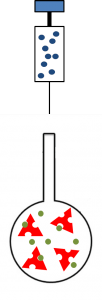In a Isothermal Titration Calorimetry experiment, If the injected volume or any of the concentrations is too small, or if the ratio between both concentration values is not appropriate, then the signal-to-noise ratio will be low and the uncertainty of any result will be high.

Determinant factors of poor quality results in Isothermal Titration Calorimetry Experiments
The control of these factors might be limited by the available amount or the corresponding solutes (they can be expensive or difficult to synthesize/purify). If the total number of titrations is low then the solute in the sample cell will not be saturated and the quality of the results will be poor. Additionally, in reactions for which multiple chemical species can be formed it is always better to simultaneously fit several experimental data series, each focusing the sampling in a different concentration region which is more sensitive to any of the species.
Advantages of prior Isotherm Simulation
The simulator tool provided by AFFINImeter allows you to test the effect of the parameters listed above on your experiment in order to optimize its design, thus saving time and samples.
Dealing with multiple curves and parameters
Within the domain of second and higher order chemical species, the number of thermodynamic parameters involved in the analysis of the corresponding systems is significant (normally 2 parameters per reaction).
A single experimental curve is usually insufficient to justify the fitting of more than a couple of parameters and so the simultaneous analysis of several curves is commonly required.
If the same binding model applies to all the measurements, the parameters of the different curves should be identical to each other. There are also situations where a different binding model applies to each experimental curve but one or more parameter is shared. This happens, for instance, when combining an experiment involving two competing molecules and a host with another experiment where one of the ligands is absent. Additionally, mainly when applying complex binding models, you may want to relate one or more parameters between them by means of analytical or logical equations. All the situations described can be easily solved using AFFINImeter.